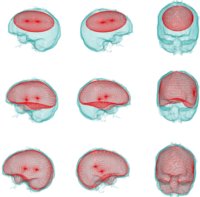Design of active contour models using NURBS
Spring 2015
Master Semester Project
Project: 00293

NURBS (non-uniform rational B-splines) curves and surfaces are widely used in the context of shape deformation. Reasons therefor are that they are defined by a set of control points and hence, moving the location of these control points directly affects the geometry of the corresponding shape. This makes them good candidates for designing active contour models with user-interaction in order to segment structures of interest in biomedical images. The construction of active contour models (a.k.a. snakes) requires two fundamental aspects to be developed:
1) an underlying geometric model (i.e. curve (2D) or surface (3D) representation) that is capable of outlining the structure of interest in the image and 2) efficient energy functionals that can be (analytically) optimised in order to attract the snake towards the boundary of interest after nearby initialisation.
The goal of this project is to design a NURBS snake (2D first stage, 3D later stage) for bioimage segmentation. It consists of a
A) theoretical part in order to develop and formulate the NURBS snake-related two fundamental aspects described above and
B) a practical part which consists in implementing the snake.
The student should be familiar with vector analysis and have some experience with objective-oriented programming such as Java or C++.
- Supervisors
- Virginie Uhlmann, virginie.uhlmann@epfl.ch, 021 693 1136, BM 4.142
- Michael Unser, michael.unser@epfl.ch, 021 693 51 75, BM 4.136
- Daniel Schmitter, daniel.schmitter@epfl.ch, Julien Fageot, julien.fageot@epfl.ch